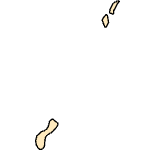Puntigrus tetrazona
(tiger barb)
Fishes
Exotic |
|
Common name: tiger barb
Synonyms and Other Names: Sumatra barb, partbelt barb, Barbodes tetrazona, Barbus tetrazona, Capoeta tetrazona, C. sumatranus, Puntius tetrazona.
Identification: Distinguishing characteristics were given by Kottelat et al. (1993). The color pattern is nearly identical to that of S. anchisporus, but S. tetrazona differs in having an incomplete lateral line and a more elongate body (Roberts 1989). Color photographs appeared in Axelrod et al. (1985) and in Kottelat et al. (1993); illustrations were provided in Petrovicky (1988), including examples of several of the color variants that exist in the aquarium trade.
Size: 7 cm TL.
Native Range: Tropical Asia - Borneo and Sumatra (Roberts 1989).



|

Alaska |

Hawaii |

Puerto Rico &
Virgin Islands |

Guam Saipan |
Hydrologic Unit Codes (HUCs) Explained
Interactive maps: Point Distribution Maps
Nonindigenous Occurrences:
Table 1. States with nonindigenous occurrences, the earliest and latest observations in each state, and the tally and names of HUCs with observations†. Names and dates are hyperlinked to their relevant specimen records. The list of references for all nonindigenous occurrences of Puntigrus tetrazona are found here.
Table last updated 12/3/2024
† Populations may not be currently present.
Ecology: Tiger barbs are generally omnivorous, consuming phytoplankton, aquatic and terrestrial insects, and other aquatic invertebrates (Shiraishi et al. 1972). They are a schooling fish, but will form temporary pair bonds during spawning. Eggs are deposited on submerged aquatic vegetation, with up to 500 eggs released per spawning event (Tamaru et al. 1997)
Means of Introduction: Probably aquarium releases. Dill and Cordone (1997) concluded that the California fish were presumably introduced by an aquarist or fish dealer wishing to use the spring as a brood pond.
Status: Failed in California, Florida, Texas, and Wyoming. Shapovalov et al. (1981) stated that no additional specimens had been taken from the California site since 1961, despite repeated collecting efforts; Hubbs et al. (1979) did not consider this fish established in that state. Repeated collecting at the Texas site offered no more specimens. Established in Puerto Rico since at least 2005 (F. Grana, pers. comm.).
Impact of Introduction: The impacts of this species are currently unknown, as no studies have been done to determine how it has affected ecosystems in the invaded range. The absence of data does not equate to lack of effects. It does, however, mean that research is required to evaluate effects before conclusions can be made.
References: (click for full references)
Axelrod, H.R., W.E. Burgess, N. Pronek, and J.G. Walls. 1985. Dr. Axelrod's atlas of freshwater aquarium fishes. Tropical Fish Hobbyists Publications, Inc., Neptune City, NJ.
Courtenay, W.R., Jr., and D.A. Hensley. 1979. Survey of introduced non-native fishes. Phase I Report. Introduced exotic fishes in North America: status 1979. Report Submitted to National Fishery Research Laboratory, U.S. Fish and Wildlife Service, Gainesville, FL.
Dill, W.A., and A.J. Cordone. 1997. History and status of introduced fishes in California, 1871-1996. California Department of Fish and Game Fish Bulletin, volume 178.
Howells, R.G. 2001. Introduced non-native fishes and shellfishes in Texas waters: An updated list and discussion. Texas Parks and Wildlife Management Data Series 188. Austin TX.
Hubbs, C.L., W.I. Follett, and L.J. Dempster. 1979. List of the fishes of California. Occassional Papers of the California Academy of Sciences 133:1-51.
Kottelat, M., A.J. Whitten, S.N. Kartikasari, and S. Wirjoatmodjo. 1993. Freshwater fishes of western Indonesia and Sulawesi. Periplus Editions, Ltd., Republic of Indonesia.
Naiman, R.J. and E.P. Pister. 1974. Occurrence of the tiger barb, Barbus tetrazona, in the Owens Valley, California. California Fish and Game 60:100-101.
Pethiyagoda, R., M. Meegaskumbura, and K. Maduwage. 2012. A synopsis of the South Asians fishes referred to Puntius (Pisces: Cyprinidae). Ichthyological Exploration of Freshwaters 23(1):69-95.
Petrovicky, I. 1988. Aquarium fish of the world. Hamlyn, London, England.
Rainboth, W.J. 1996. Fishes of the Cambodian Mekong. FAO Species Identification Field Guide for Fishery Purposes. Food and Agriculture Organization of the United Nations, Rome. http://www.fao.org/docrep/010/v8731e/v8731e00.htm.
Roberts, T.R. 1989. The freshwater fishes of Western Borneo (Kalimantan Barat, Indonesia). Memoirs of the California Academy of Sciences 14:1-210.
Shafland, P.L. 1976. The continuing problem of non-native fishes in Florida. Fisheries 1(6):25.
Shiraishi, Y., N. Mizuno, M. Nagai, M. Yoshimi, and K. Nishiyama. 1972. Studies on the diel activity and feeding habit of fishes at Lake Bera, Malaysia. Japanese Journal of Ichthyology 19(4):295-306.
Shapovalov, L., A.J. Cordone, and W.A. Dill. 1981. A list of freshwater and anadromous fishes of California. California Fish and Game 67(1):4-38.
FishBase Summary
Author:
Leo Nico, Pam Fuller, Matt Neilson, and Bill Loftus
Revision Date: 7/24/2019
Peer Review Date: 3/11/2013
Citation Information:
Leo Nico, Pam Fuller, Matt Neilson, and Bill Loftus, 2024, Puntigrus tetrazona (Bleeker, 1855): U.S. Geological Survey, Nonindigenous Aquatic Species Database, Gainesville, FL, https://nas.er.usgs.gov/queries/FactSheet.aspx?SpeciesID=635, Revision Date: 7/24/2019, Peer Review Date: 3/11/2013, Access Date: 12/3/2024
This information is preliminary or provisional and is subject to revision. It is being provided to meet the need for timely best science. The information has not received final approval by the U.S. Geological Survey (USGS) and is provided on the condition that neither the USGS nor the U.S. Government shall be held liable for any damages resulting from the authorized or unauthorized use of the information.